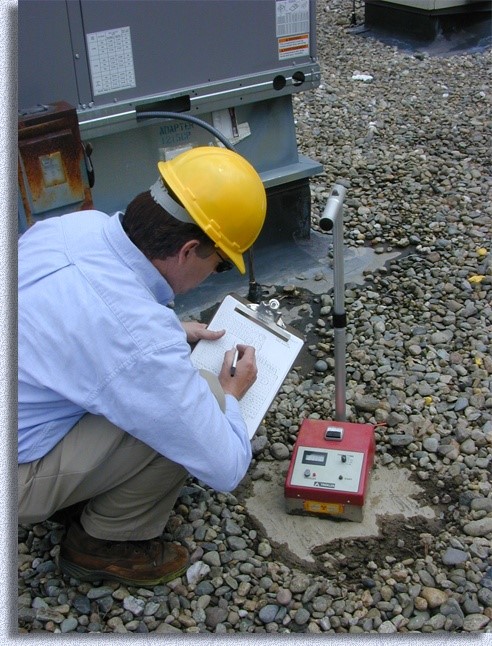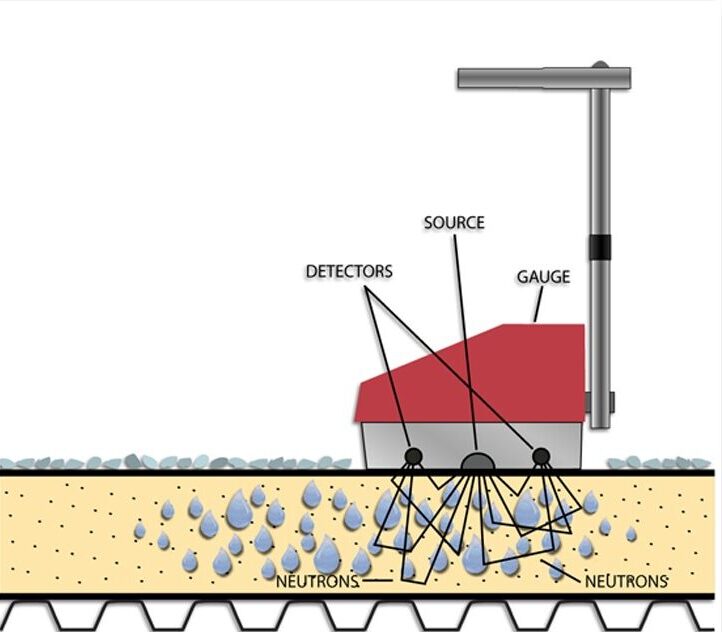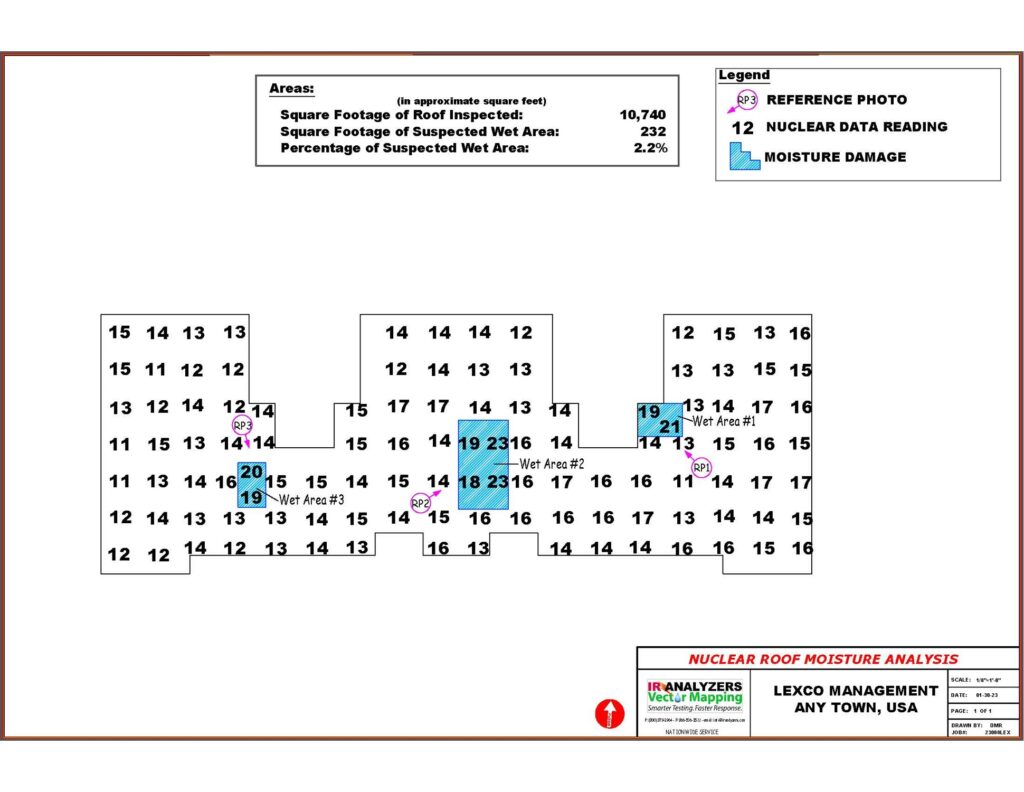Call Now (800) 879-1964
When it comes to protecting a commercial roof, what you can’t see can cost you. Moisture
trapped beneath the surface often goes undetected until it causes serious problems, damaging
building contents, disrupting operations, voiding warranties, and accelerating system failure.
That’s where nuclear testing comes in.
A Nuclear Moisture Gauge provides non-destructive, highly accurate detection of hidden
moisture within roofing assemblies. Unlike infrared scans that rely on surface temperatures,
nuclear testing measures the amount of hydrogen in the assembly. Once baseline hydrogen
values are established for dry materials, elevated hydrogen levels typically indicate increasing
amounts of water damage (H2O) and uncover water intrusion that other methods might miss.
In this guide, we’ll break down how nuclear testing works, when it’s the right tool for the job, and
how IR Analyzers uses this technology to help clients make confident, data-backed decisions
about their roofing systems.
The Troxler® 3216 Nuclear Roof Moisture Gauge is an extremely sensitive and accurate
instrument for determining the locations and extent of moisture damage in insulated roofing
systems. In the context of commercial roofing, it allows our technicians to assess the condition
of insulation and other materials that may be holding hidden moisture.
The instrument works by emitting low-level radiation from a sealed source into the roofing
materials. Sensors then detect how that radiation interacts with the material, allowing us to
locate and document the moisture content with a high degree of accuracy.
A nuclear moisture gauge works by emitting low-level gamma radiation from a sealed radioactive source Americium-241:Beryllium - within the unit.
By employing a principle called neutron moderation, these tiny radioactive releases detect hydrogen
ions, and provide a count of how many hydrogen atoms there are in the assembly. Neutrons emitted
from an isotopic source collide easily with the highly exposed neutrons of hydrogen, and these
collisions slow their travel. By detecting changes in the speed of the emitted neutrons, it is possible
to quickly, safely, and accurately identify moisture in the roof.

It is important to understand that the gauge is actually counting the number of hydrogen atoms
in the assembly. Because other hydrogen bearing materials are present in roof structures, it is
critical to establish a relative base level or gauge reading that indicates dry materials. Areas
showing a higher than normal moisture count can then be determined to contain varying
amounts of moisture.
All Roof Moisture Survey techniques utilize technologies that measure a characteristic of the
assembly that can then be interpreted as moisture damage, but does not directly identify the
difference between wet and dry materials.
Infrared Roof Surveys pinpoint moisture through the interpretation of thermal anomalies on the
roof surface. When the conditions are set up correctly, areas of moisture damage will manifest
as warmer anomalies on the roof surface versus cooler patterns of dry insulation. Capacitance
Testing utilizes electrical currents to measure electrical flow through the materials. Moisture can
be detected because moisture-damaged materials will have less electrical resistance and
conduct the current more rapidly.
It is very important to understand that the nuclear gauge is also not directly measuring moisture.
It is sensing the amount of hydrogen in the system. All hydrogen in the assembly will register on
the gauge. Certain assemblies like single-ply membranes (TPO, PVC, EPDM, etc.) over cover
boards and insulation will have relatively small amounts of background hydrogen in dry
materials and therefore lower hydrogen baselines. However, hydrocarbon-based assemblies
containing asphalt or cold tar pitch can naturally contain significantly more hydrogen, resulting in
background (dry) counts that are typically higher.
In addition, single-ply membrane assemblies are typically quite homogeneous regarding the
amount of baseline hydrogen. However, with asphaltic and cold tar pitch assemblies, there are
often greater variations in material thickness, and the background levels of hydrogen will vary
accordingly. These assemblies can present readings that are more challenging to interpret, as
higher readings might represent greater amounts of hydrogen-containing materials rather than
moisture damage. These concerns can be largely mitigated by employing experienced Certified
Technicians who are able to calibrate the gauge with selective invasive testing (core samples).
Although this technology is commonly used in soil compaction testing, its application in roofing is tailored to evaluating insulation health and waterproofing integrity. Here’s how the procedure typically unfolds in the field:
Nuclear data points are measured and marked on the roof on a grid, typically with 10 ft
intervals on the X and Y axes. Some surveys are conducted with 5 ft intervals or even 3
ft by 3 ft intervals, depending on the size of the roof, and the desired degree of
granularity.
The nuclear gauge is placed directly on the membrane, and the hydrogen count of the
roofing materials is measured and recorded. Nuclear Roof Moisture Surveys are typically
conducted on a 10’ x 10’ grid pattern across the entire roof surface. On ballasted roofs,
the rocks will be temporarily moved aside in order to place the nuclear gauge directly on
the roof surface. Readings are taken at each grid intersection to create a hydrogen
profile of the roof system.
The gauge emits gamma rays into the roofing system. Based on the characteristics of
the backscattered radiation, the system calculates actual hydrogen counts and flags
areas likely to contain moisture. Ideally, selected core samples are employed to calibrate
the gauge and absolutely determine the presence or absence of moisture. If it is not
possible to cut core samples (warranty issues, owner restrictions, etc.), estimations will
have to be made as to the significance of the numbers, higher and lower. If no physical
core sampling is done to establish ground truth conditions, the findings will be presented
as suspected or probable areas of moisture damage.
Hydrogen Baselines: To accurately analyze the data from this sensitive nuclear
detection technology, we must account for the original hydrogen content of dry roofing
materials. By utilizing small amounts of invasive testing, hydrogen readings can be
established for dry materials. After dry material baselines are established, elevated
hydrogen counts typically indicate moisture damage in the roof system.

Ideally, core sampling can be performed to establish dry reading baselines and verify
moisture in areas with elevated hydrogen counts. This empirical approach will greatly
enhance the reliability of the testing. In situations where it is not possible to perform core
sampling of the assembly, the hydrogen baselines must be estimated, and elevated
readings will be assumed to represent moisture damage.
A comprehensive report is compiled and submitted that details the test procedures,
locations and findings of any invasive testing, and AutoCAD drawings of test results
including grid layout, hydrogen counts, locations of moisture damage, and percentages of
wet and dry materials.
Before, during, and after the survey, the unit is stored, transported, and utilized in
accordance with all federal and state regulations.
Possessing and operating nuclear moisture gauges requires licensing and certification
by federal, state, and occasionally local authorities. To eliminate risk on the part of our
company and our customers’ companies, IR Analyzers always conducts the testing in
accordance with all applicable authorities.
All IR Analyzers Certified Technicians:
These procedures ensure that nuclear testing is conducted safely, not only for our team but for building occupants, site personnel, and the environment.
Nuclear density gauges are one of the most precise tools available for detecting hidden moisture in commercial roofing systems. At IR Analyzers, we deploy this technology to conduct our Nuclear Roof Moisture Surveys, when conditions call for deeper insight than visual inspections or infrared scans can provide.
While not every project requires nuclear testing, there are several situations where it's the most appropriate—and often the most effective—choice.
Our technicians typically recommend Nuclear Roof Moisture Surveys in scenarios like:
Unlike Infrared Surveys, Nuclear Testing can be relied upon to produce highly accurate
information on reflective membranes (cool roofs).
Nuclear Testing is the only reliable technique for determining the locations and extent of
moisture damage in ballasted roofing systems (covered in 1 -1.5” river rock).
Nuclear has the advantage of being able to read much more deeply into a roof assembly
than the infrared camera. This can be very beneficial in multi-layer systems, or when
there is concern about moisture near the bottom of the system, especially if it is present
under dry insulation.
Nuclear surveys do not rely on the sun’s heat to warm the wet insulation, so Nuclear
Testing provides excellent information in shaded areas, ensuring that 100% of the roof
assembly is tested.
After major weather events, nuclear testing helps verify the true condition of the
assembly, often a requirement for warranty claims or insurance documentation.
For property acquisitions, condition assessments, or budgeting major repairs, due
diligence Nuclear Moisture Surveys give you the comprehensive and accurate
information needed to make data-driven decisions that save time and money.
If you're considering a Nuclear Roof Moisture Survey, you're likely asking: What will the results tell me, and how will they help me make the right decision for my roof?
This test is designed to detect and quantify moisture within roofing systems. After the test, you’ll
receive a detailed report that includes:
These results help you understand whether you're dealing with isolated wet areas or more
serious moisture damage.

Your test results are decision-making tools. With these insights, you can:
At IR Analyzers, we focus on providing objective reports that are designed to be clear, actionable, and aligned with industry standards, so you can confidently make decisions about your roof system.
When it comes to identifying hidden moisture in commercial roofing systems, precision and
experience matter. IR Analyzers has been at the forefront of non-destructive roof testing for over
40 years, with a reputation built on technical expertise, reliable data, and responsive service.
Every Nuclear Roof Moisture Survey is performed by licensed professional Certified
Technicians trained in both radiation safety and advanced testing procedures. Our technicians
bring unmatched knowledge to every project, ensuring accurate testing and clear interpretation
of results.
Whether you need to confirm roof conditions, support a warranty claim, or plan critical repairs,
our Nuclear Roof Moisture Surveys give you the insight you need accurately, safely, and on
schedule. Because of the accuracy and reliability of Nuclear Moisture Surveys, billions of
square feet of roofing have been safely and accurately analyzed with nuclear testing.
Ready to schedule your survey? Contact our testing team today.
